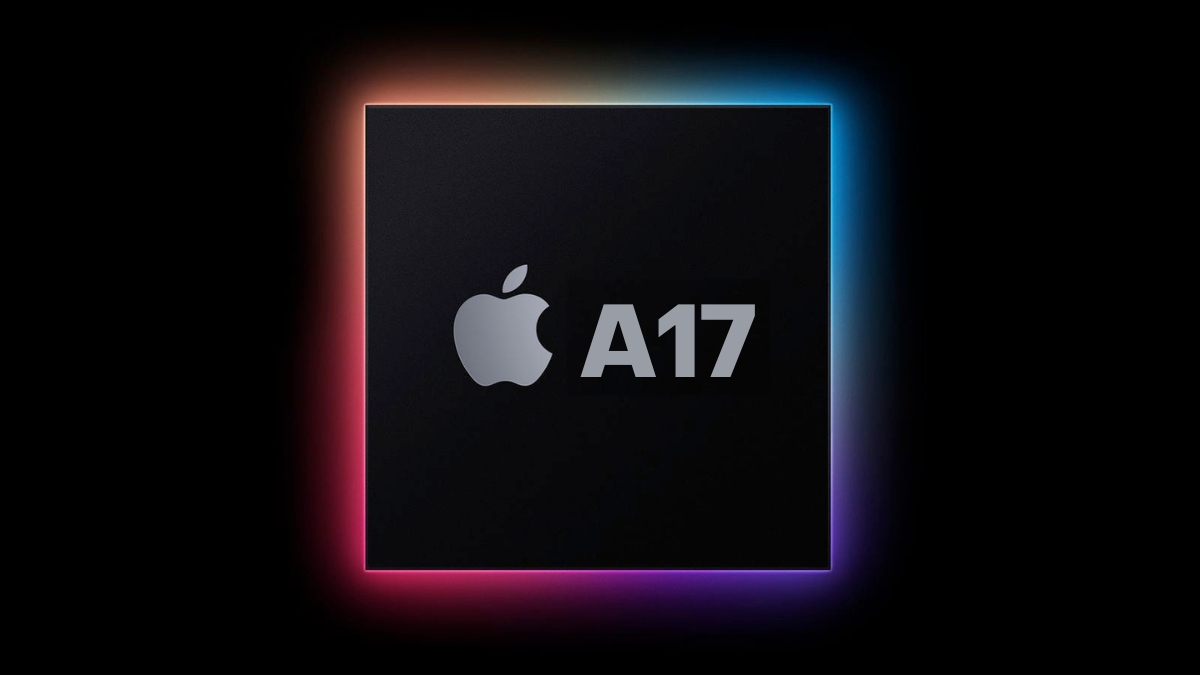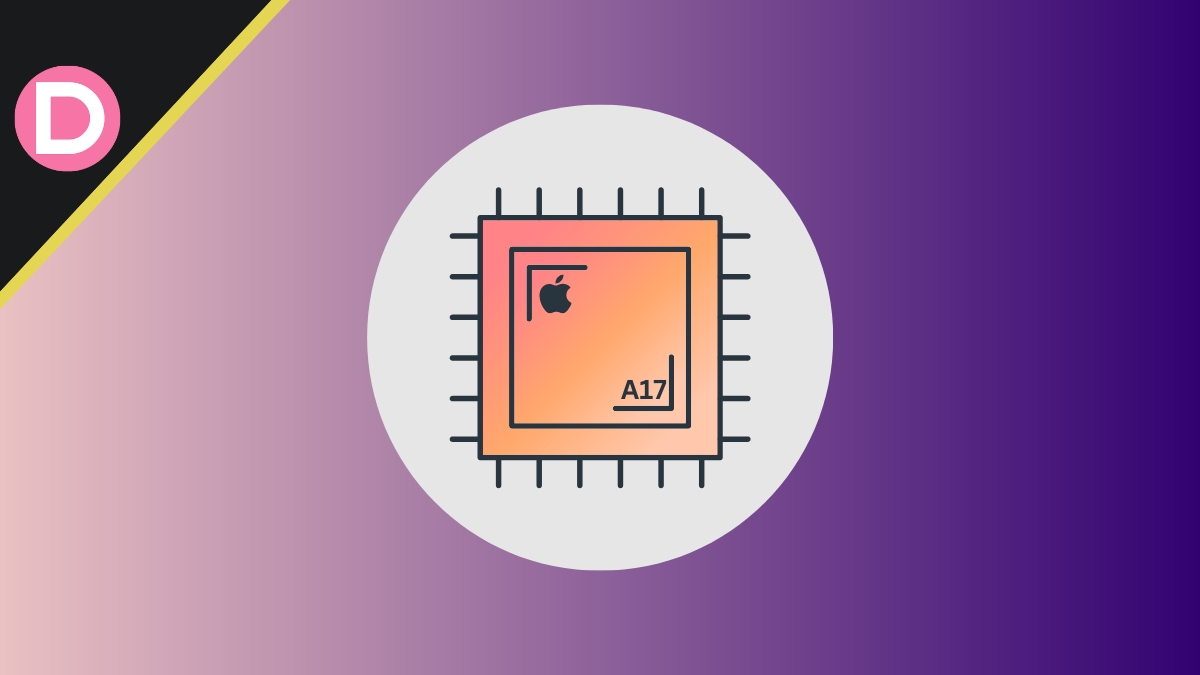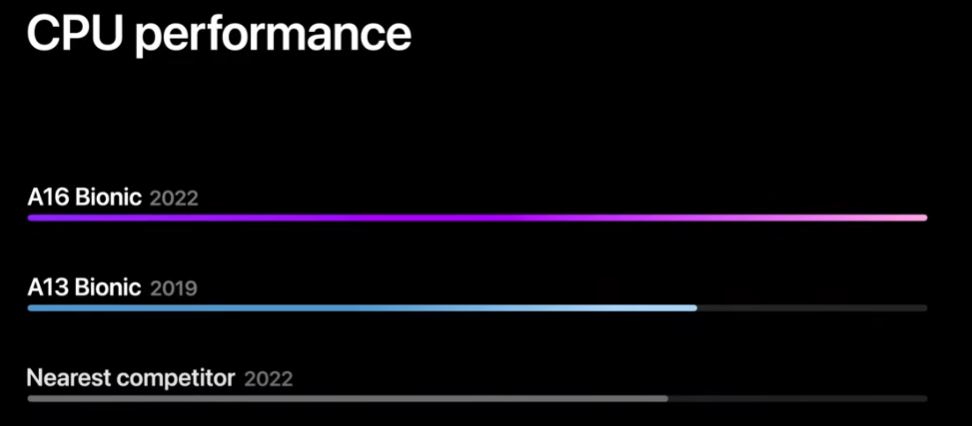Apple began a new strategy in 2022, where only the Pro models got the latest chips. We saw early signs of this in 2021 since the GPU on the vanilla iPhone 13 only got a 4 Core GPU instead of the much better 5 Core GPU on the Pro model.
Apple makes the SOC on the non-pro models worse since they don’t have high refresh rate displays. As a result, games will not run at 120FPS, and a high-power GPU is pointless.
Bionic chips are usually a cut above the competition. That’s partly thanks to Apple’s excellent chip designing team and TSMC fabrication. However, the last two generations of Apple’s chips aren’t significant upgrades from the previous generations.
The A16 Bionic was such an incremental upgrade that Apple didn’t compare it with the A15 Bionic or the Snapdragon 8 Gen 1 but with the A13 Bionic, a three-year-old chip.
Apple’s chips indeed have world-class efficiency since Apple’s hardware and software teams work beautifully together for a cohesive experience; that gap is rapidly closing with new Android chips like the Snapdragon 8 Gen 2.
Since iPhone chip innovation is nearly stagnant, we need a significant GPU upgrade and an efficiency boost for the A17 Bionic.
iPhones are now behind the Android competition in performance since they aggressively dim the displays if you push the performance. They also let the temperatures go over 40 degrees Celsius.
In this article, we’ll discuss the A17 Bionic, which will power the new iPhone 15 models, and how it could fare against the competition.
A17 Bionic: What’s New and What to Expect?
Apple is planning to allocate a higher budget for the design of the A17 Bionic. Since the A15 and A16 didn’t have any notable bumps in performance, Apple is supposedly increasing the headcount of chip design engineers to keep up with the competition.
If chipset upgrades slow down, one primary reason for someone to upgrade is gone. We’re not seeing much overall smartphone innovation either.
Camera sensors are getting slightly larger with tiny differences in image quality, and many refinements are from the software.
We nearly saw chip innovation completely nosedive until the 8+ Gen 1 in 2022. TSMC’s 4nm fab makes the 8+ Gen 1 a compelling chip, even in 2023 smartphones.
Since Apple doesn’t want annual smartphone sales to suffer, they must return to the chip game. Analyst Ming-Chi Kuo believes that Apple is allocating more resources and paying more attention to chip design.
If Apple spends more time and resources on IC design, we’ll see better performance, efficiency, and thermal control. Apple has a particular app optimization perk, too.
The M2 wasn’t much of an upgrade from the M1, and the M1 was built on the A14 architecture. Since the A15 and A16 weren’t massive upgrades either, Apple’s laptop chip innovation is slowing down, too.
We can expect a better CPU with more power, efficiency, and GPU. We might even see Ray Tracing support. If iPhones start using active cooling systems, iPhone users can use all that raw power.
We’re waiting for 3nm chips, and 2023 is probably the year they go mainstream. TSMC’s 3nm fabrication was delayed many times, so it’s possible that they finally worked things out.
A17 Bionic Versus the Rivals
Two of the biggest competitors to the current A16 Bionic are MediaTek’s Dimensity 9200 and Qualcomm’s Snapdragon 8 Gen 2. The 8+ Gen 1 already beats the A15 regarding Genshin Impact frame rate stability, so it isn’t looking great for Apple Silicon.
SOCs aren’t just about performance since phones perform camera processing through Image Signal Processors.
We don’t know much about ISP improvements on the A17 Bionic, but the A16 faces severe criticism for poor highlight management and computational photography. We hope Apple rethinks its high dynamic range algorithm for the A17 Bionic.
The 8 Gen 2 has a much better ISP thanks to the Cognitive Engine with semantic segmentation.
The A17 Bionic will initially go up against the Snapdragon 8+ Gen 2. We may already have seen the 8+ Gen 2 on the S23 series since it follows the same pattern of little CPU and GPU overclock.
The 8 Gen 2’s GPU with Ray Tracing is already more efficient than the A16. Unfortunately, we can’t test the Ray Tracing yet since there aren’t any games.
Later, the A17 has to compete with the Snapdragon 8 Gen 3. We don’t know much about the 8 Gen 3 since the 8 Gen 2 just came out, but it’ll probably feature a 3nm fabrication from TSMC or Samsung. Reportedly, the customized 8 Gen 3 for Galaxy will beat A17 Bionic.
Whether or not Samsung’s 3nm process is effective will determine the results of these comparisons. If it’s on par with TSMC’s 3nm fabrication, we’ll see evenly matched chips.
Unfortunately, according to a new report, Apple already bought all the 3nm Silicon from TSMC, so that things could get complicated for Qualcomm. If Samsung’s 3nm node does not meet expectations and yield rate conjecture, Apple will conquer chips again in 2024.
What about TSMC 3nm?
We’ve seen plenty of news about TSMC’s 3nm fabrication process. Apple plans to use 3nm chips until 2025. High-volume mass manufacturing of TSMC, 3nm chips, began in Q4 2022.
TSMC is not struggling with profits since they generated 34 Billion Dollars in revenue last year. Since many future products will use 3nm chips, TSMC invests tens of billions of dollars.
There were many delays in N3 production, probably because the fabrication process is very complex. TSMC’s original plan was to make 3nm chips in 2022, but it’s now looking like 2023 is the year for that, with Apple’s Bionic chips carrying the N3 node first.
We expect to see a more advanced N3E node later in the year. TSMC’s global expansion is going well, too, with the company aiming to manufacture 4nm and 5nm chips in the USA in 2026 or before.
There are many disputes about Apple’s orders with TSMC this time. Some reports claim that Apple is the sole customer of their new N3 chips, while others claim that Apple cut down their orders for Silicon Wafer.
Even if we see N3E launch in 2023, there aren’t many clients for TSMC, and many manufacturers are happy with 5nm (and 4nm) processing.
Is 4nm actually 4nm?
We’re always on the hunt for smaller transistors. That’s the only way we can increase the performance of a chip.
The smaller the transistor is, the more you can pack into a chip. Also, smaller transistors will enable better power efficiency. Transistor size went from 7nm to 5nm to 4nm in just a few years.
It’s not widely known, but TSMC’s 4nm processing isn’t 4nm. The nodes N5, N5P, and N4 all belong to 5nm fabrication, and advertising the A16 Bionic as a 4nm chip was pure marketing. There aren’t any physical differences in these nodes at all.
The 4LPX node on the 8 Gen 1 and 5LPX node on the 888 are both 5nm nodes, and Samsung’s yield rate issues come from rushing the 4nm node. The Exynos 2200, which has the real 4nm (4LPE) node, is inefficient and suffers from heating issues.
Relabeling old fabrications with new names is a clever marketing ploy, and we hope TSMC’s 3nm chips don’t go down that route.
Samsung’s 3nm GAA is promising since the yield rate looks fine. We’ll have to wait and see if major companies use Samsung fabrication again after the fiasco with the 888 and the 8 Gen 1.
Apple probably agreed to TSMC’s price hike to secure the 3nm chips for themselves. We’ll only see these on the latest iPhone 15 models.
Apple’s internal chip design conflicts
Apple allegedly had major plans for the A16 Bionic. It didn’t ship with anything noticeably new from the A15, and this is due to internal team conflicts.
Many of Apple’s engineers left to join other companies, and the engineering team spotted a flaw late in the development stages. This made the chip overheat, causing problems in everyday use, too.
Since Apple didn’t want to ship this faulty chip, they scrapped the plans entirely. The A16 instead came with incremental updates to the A15. However, the A17 might have all of these improvements.
We expect Ray Tracing support for the GPU, better ISP, better CPU performance, and improved efficiency.

Will the vanilla iPhone 15 models get the A17 Bionic?
The iPhone 13 lost one GPU core, and the vanilla iPhone 14 didn’t even have the latest chip. The iPhone 14 ships with the same A15 Bionic as the iPhone 13 Pro, with a 5-Core GPU and 6GB RAM.
That’s not a brilliant move for consumers. Apple probably did it to save costs amid the global chip shortage and component price increases.
If we follow this pattern, Apple has no reason to include the latest chip on the vanilla models. Even if they do, that performance is useless since they have 60Hz screens.
Using older chips didn’t affect the sales too much, so Apple will most likely stick to the one-year-old A16 Bionic for the vanilla iPhone 15 and 15 Plus.
Only the new iPhone 15 Pro and the Pro Max (Or Ultra) will use the latest A17 Bionic. This will push the gap between regular and Pro even further.
In other news, the upgrades look very good for the iPhone 15 Pro/ Max. Along with the new chip, we expect a pericope zoom camera, better dynamic range, a new design, and haptics for the buttons.
Furthermore, according to analyst Ming-Chi Kuo, Apple isn’t focusing much on its own Wi-Fi & Bluetooth chips anymore. They’re investing their time and money into SOC design, so they’re sticking with Broadcom and Qualcomm to supply modems for a while.
Work on a Bluetooth+ Wi-Fi chip is ongoing, but we probably won’t see it in 2023 or 2024. Apple plans to make its display in-house, giving them even more control over the iPhone prices.
Conclusion
Apple will be the first company to introduce a consumer electronics product with 3nm fabrication. Samsung could’ve done it with their 3nm chips, but they chose to wait until probably the Exynos 2300 or 2400.
The A17 Bionic will debut with the iPhone 15 Pro, which we’ll probably see in September 2023. Since it’s the first time we see a new node in action, we hope it doesn’t suffer from thermal problems.
Apple lets its chips run hot on purpose to maximize performance but then tries to compensate with aggressive display brightness dimming. This is annoying if you play shooter games, where you can miss the target if the screen isn’t bright enough.
We still don’t have an active cooling system on iPhones. They still use traditional thermal paste. Competitors use large vapor cooling chambers or liquid cooling to achieve better sustainability.
Many people thought we’d see liquid cooling on the iPhone 13 Pro or 14 Pro, but neither of those models got it. We still don’t have much information about the clock speeds of the CPU and GPU or the RAM type. Apple will probably stick to fast NVME SSDs.
There are some predictions that the new flagship iPhone will have 8GB of RAM, and that’s necessary since iPhones pause a lot of background tasks to keep apps open.
Some reports claim that TSMC’s 3nm isn’t 3nm (3.94nm) and that Samsung (3.55nm) has the upper hand this time. We can’t take it seriously since the reports have no reasonable basis or sources.
Forcing your chip to exceed 3.55nm with current technology causes overheating, inconsistent performance, or power leaks.
Note: We’ll update this live article with the latest news.




